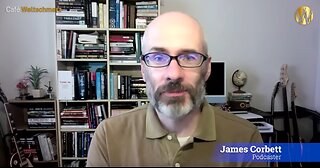Premium Only Content

The Origins of AIDS (2004)
A documentary about the hypothesis that HIV may have been caused by mass vaccination against Polio, in Congo, between 1957 and 1960.
Directors: Peter Chappell, Catherine Peix Eyrolle (as Catherine Peix)
Writers: Peter Chappell, Stéphane Horel
Stars: Cecil Fox, Simon Wain-Hobson, Joseph Vandepitte
https://www.youtube.com/watch?v=gRTpThZrDAY
_________________________________
Posted on 4th January 2007 by Edward Hooper
The Death of Professor Paul M. Osterrieth – and its Significance for the Origins of AIDS debate
Professor Paul Osterrieth’s long struggle is over. The man who worked at the Laboratoire Medical de Stanleyville (LMS) between 1956 and 1960 (for the last three years as head of the virology lab) died shortly before Christmas, and he was buried on December 22nd, 2006 at his village in the Ardennes. I am reliably informed that there was a large congregation at his funeral, including fellow-professors from his last place of work, the University of Liege, at least one of whom spoke warmly about him at the service. Although I cannot confirm this, I believe that he was about 81 years of age.
I came across Dr Osterrieth only three times, but I have vivid memories of each occasion. I had two formal interviews with him, in 1993 and 1994, and I saw him again at the Royal Society meeting on “Origins of HIV and the AIDS epidemic” in Sepember 2000.
The first interview was a day-long affair, which began after he picked me up at the local station early in the morning. I was invited to join him and his wife for breakfast, during which his wife asked me if I intended to question her husband about the theory that CHAT vaccine, the oral polio vaccine (OPV) that had been subjected to tests and field-trials at the LMS in the 1950s, had somehow been involved in the origin of the AIDS epidemic. I answered that this was indeed one of several things I wanted to ask Dr Osterrieth about, and almost immediately he disappeared from the room. When he returned five or ten minutes later, he was looking grey with concern. During the remainder of the day Dr Osterrieth was courteous and kind, and he answered most of my questions, but it was clear that at several junctures he was distinctly uneasy.
Some of the easiest questions that I put to him (such as how many chimpanzees had been used in the course of the polio research at the LMS, and what had eventually happened to those animals) stumped him completely, while others caused him to ponder for lengthy periods before answering. The question that caused him most difficulty was which primate he had been using to make tissue culture in the laboratory, in order to grow his viruses. There was a long pause, and he eventually said that he couldn’t remember. I started to prompt him: had he perhaps been using the kidneys of African green monkeys, or chimpanzees? His response to the latter was unexpectedly rapid: “No, no – not chimpanzees.”
Later on, after I happened to mention that another virologist, Pierre Lepine, had been using baboons from Africa to make tissue culture during the late fifties, Osterrieth volunteered that “if Pierre Lepine would use [baboon tissue], it’s probably likely we did” at the LMS. But his statement was far from convincing.
My question about the chimps had been legitimate, for between 1956 and 1960 over 500 chimps had been utilised at Lindi camp, an experimental chimpanzee holding centre which Osterrieth’s boss, the LMS director, Ghislain Courtois, had set up in the rain forest just outside Stanleyville. The avowed reason for establishing this camp had been that it would permit the testing of the experimental OPVs of Polish-American virologist, Hilary Koprowski, and some 400 chimps were used specifically on this polio research. The camp had originally been called the “Mission Courtois-Koprowski”; the local Congolese called it “Camp Polio”.
At another point in the interview, I explained to Dr Osterrieth that I had found records indicating that he had extracted kidneys from some of the Lindi chimps, and sent them to the US (where, incidentally, they had later been used to make tissue culture, which was reportedly used in an attempt to grow hepatitis viruses). After some intitial hesitation, he wryly acknowledged that if this was recorded on paper, then he must have done it. But he insisted that they had only made “a little” tissue culture (type unspecified) at the LMS itself. This seemed very strange, given that making tissue culture was the primary purpose of a virology laboratory, and given that (as he himself told me) he had been invited to train at the Wistar Institute in 1957 “for maybe one or two weeks”. He added that he had had “a very funny time at that lab, because I never knew exactly why I was there”. What he forgot, however, was that near the beginning of the interview he had told me that Koprowski had invited him to the Wistar specifically because of “the polio work”, and in order to study tissue culture techniques. (Interestingly, in a later publication, he wrote that he had actually trained at the Wistar for “a month”.)
Towards the end of the day, once Dr Osterrieth had rediscovered his equilibrium, I discussed the OPV/AIDS theory with him. He said that he didn’t think it was plausible, mainly for three reasons. Firstly, although he admitted that lymphocytes (which theoretically could have contained simian immunodeficiency viruses, SIVs, the ancestors of the HIVs) would have been present in the tissue cultures used to make CHAT vaccine, he did not think that any SIV could have survived through to the final vaccine; secondly, he said that the oral route was not an effective route of infection for SIVs and HIVs; and thirdly, he said he thought that the vaccine had in any case only been given to about 2,000 people in the Congo. (All of these arguments were later revealed as flawed, or spurious: most especially the last, for nearly one million Africans received the experimental OPVs between 1957 and 1960.)
Before I left, he stressed that the OPV theory was “a political time-bomb”, adding: “And there is no evidence – I mean hard facts. The only good way would be to prove that there is [an SIV] in CHAT vaccine. All the rest is coincidental, and is very dangerous…..I would say that if you’re not 100% sure, then don’t publish.” At the time, this sounded like sensibly cautious advice.
Looking back at the transcript of this interview from the perspective of 2007, I can see that it was characterised by two major elements. Dr Osterrieth failed to give any specific details about what he actually did do at the LMS and Lindi with the polio vaccines and chimpanzees, and at all times he tried to minimise the importance of this work, and his own involvement with it. Over the last few years, I have acquired documentary and testimonial evidence which proves beyond doubt that many of the careful (and sometimes laboured) statements he made during that interview were untrue. But back in 1993 all I had was the gut feeling that not all that he had told me added up.
Almost a year later, I returned to Dr Osterrieth’s pretty farm in the Ardennes for a second interview, only to find that his previously kindly attitude had changed. This time he was brusque from the outset, and became even more irritable when he learnt that I still believed the OPV theory to be viable. Now he denied several of the statements he had made a year earlier, such as the fact that he had sent chimp kidneys to the States. Presently I showed him a copy of the 1959 LMS annual report, which revealed that 250,000 doses of CHAT vaccine had been “conditioned” in the laboratory. Did this mean that a batch of CHAT had been prepared in the LMS?, I asked. “CHAT certainly wasn’t prepared in the lab. Transferred from one bottle to another, maybe, but not prepared”, he answered briskly. “Of that I’m 100% sure, because I was making the tissue culture.” By contrast, his answers to many of my other questions were once again extremely hesitant. It became increasingly clear to me that he had decided before the interview to stick to the line that he himself had been hardly involved with the polio research, or with the chimpanzees. I was quite shocked by his manner and by his denials, and before I had asked even half of my questions, I decided to thank him and to abandon the interview.
(As it turns out, Osterrieth’s explanation for the “conditioning” of a quarter of a million doses of CHAT, which took place at the very end of 1959, was probably correct. It was what had happened to the vaccine in the years before then that was crucial. But by a happy chance, my question did elicit the clear statement that he himself had been the one making the tissue culture at the LMS.)
That was 1994. Five years later, my book The River was published, in which I carefully outlined the reasons why I believed that OPV/AIDS remained a viable, and indeed a compelling theory. The increasingly favourable reviews that the book engendered forced the scientific community to acknowledge that the theory deserved to be examined properly, and to that end a two-day discussion meeting on “Origins of HIV and the AIDS epidemic” was organised at the Royal Society for the month of September 2000. Dr Osterrieth was invited to deliver a short address to the meeting.
For reasons beyond my control I was not present during his five-minute speech, but I heard about it afterwards, and subsequently listened to a tape recording. Although Osterrieth admitted that he had sent “six minced chimpanzee kidneys” to the States, he made no mention of any other work involving chimpanzees, and he now even denied that the CHAT vaccines from the US had ever been handled in his lab. He said that the only success that he had enjoyed making tissue culture had been with baboon kidneys, implied that this had not happened until mid-1958, and added that even then he had succeeded in making only 200 tubes and ten bottles. “There is no possibility that chimpanzee cells could have contaminated the vaccine”, he concluded.
His brief paper was entitled “Vaccine could not have been prepared in Stanleyville”, though apart from assertion, there was nothing in his paper to support this sweeping statement.
Indeed, within weeks of the meeting I discovered that it was the norm in the 1950s for polio vaccine to be amplified in locally available primate cells upon arrival at a recipient laboratory in Africa. Part of the reason was to keep the vaccine virus alive, though such amplification also served to boost the quantity and concentration (or titre) of the vaccine, which allowed greater numbers to be vaccinated. Significantly, before 1960 there was no specification about the species of primates that could and could not be used for polio vaccine preparation in this manner. Vaccine had merely to be prepared in tissues which originated from healthy animals, and which showed no evidence of contamination. One suspects that, not for the first time the world of science, the totals on balance sheets may have played a major role.
As an aside, there was another interesting event that occurred during the course of the Royal Society meeting. A French photographer asked Dr Osterrieth is he could take a photo of him. Osterrieth refused, and apparently added that if the photographer snapped a photo without permission, he would “break [his] camera”. The young photographer, having never been threatened like this before, was quite shocked.
One of the co-organisers of the meeting, retrovirologist Robin Weiss, summed up at the end of the conference, and described Osterrieth’s speech as “resonant”. However, in an e-mail sent the following year to a jourmalist who asked specifically about Osterrieth’s testimony, he put it rather differently. “Either Osterrieth is lying through his teeth or [Hooper] has got it wrong”, he wrote; the remainder of the e-mail made it clear that he firmly subscribed to the latter scenario. [I should perhaps add that Weiss’s e-mailed reply to the journalist was quite an eye-opener. It was profoundly biased, and he based two of his four answers on shameless misquotations from my latest paper (of which I myself had given him a copy just a week earlier).]
In just one instance, Osterrieth had some evidence to support his claims at the Royal Society meeting. The sole reference to tissue culture in the LMS annual reports occurs in the 1958 report; which clearly states that tissue culture was made “exclusively from baboons”, and that just 200 tubes and ten bottles had been made. Strangely, the quantity described would in fact have been the product of just a single pair (or at most two pairs) of baboon kidneys.
Even at the time of the Royal Society, I already had evidence to suggest that significant parts of what Dr Osterrieth was now stating were incorrect, and soon afterwards a great deal more counter-evidence came to light. In April 2001 I revisited Kisangani (formerly Stanleyville) accompanied by a film crew making a documentary (later released as “The Origins of AIDS”), and this time I was able to interview several Congolese workers who had witnessed the procedures at Lindi camp and the LMS with their own eyes. (During my previous visit in July 1999 I had only located one truly significant witness; apparently someone did track down several other witnesses on my behalf, but unfortunately he arrived at the hotel with his exciting news just after our departure.)
But back to 2001. Two former caretakers from Lindi camp stated that all but about 60 of the several hundred chimpanzees held there had eventually been sacrificed (killed), and that many of them had been anaesthetised before sacrifice, so that blood and vital organs (including kidneys) could be removed while the animals were still alive. Only after the operation was the coup de grace administered. At the time, this was the standard method of sacrifice employed when collecting tissues for making tissue culture.
A Congolese technician working at the LMS made a simple but stunning statement. He said that most of the tissue culture that had been made in the lab in the late fifties had come from chimpanzees. However, he recalled next to nothing about the methods that had been employed, and I felt that this still fell somewhat short of substantive proof.
However, another technician, Jacques Kanyama, who had been employed in Osterrieth’s own virology lab, where he worked especially on the cleaning and sterilisation of glassware, stated that chimp materials had regularly been brought to the lab, and that furthermore Dr Osterrieth had regularly been making polio vaccines there, vaccines that were later administered to local adults and children. How did Jacques know that Osterrieth had actually been making the vaccines? Well, he undertook this process after hours in his own private lab (which was in fact the sterile room, where tissue cultures were prepared and handled), and he did it every time a new request came in for polio vaccine from another provincial doctor. The quantities of vaccine were always much larger after he had finished. [I address below the question of whether Osterrieth had actually been making the vaccine as Jacques believed (ie amplifying the vaccine that came from the US in local tissue culture), or simply diluting the American vaccine in saline solution.]
It was this final interview that represented the “Eureka moment” when the light-bulb went off, and I finally realised that, despite the insistent denials by the vaccine-makers, at least some of the batches of CHAT vaccine administered to more than 900,000 people in the Belgian Congo and Ruanda-Urundi between 1957 and 1959 appeared to have been amplified (or regrown) locally in the LMS. On the basis of the first technician’s testimony, it seemed highly probable that this had occurred in chimpanzee tissue, and (on the basis of an internal report about the Lindi chimps published in the US) that the tissue cultures had also employed chimpanzee sera as growth medium.
Nearly 18 months after this, I revisited Pierre Doupagne, who had worked as chief technician at the LMS from 1949 to 1960. I had always respected M. Doupagne, and this time we spoke together for almost an entire day. I told him what I had been told by the African chimp caretakers and lab technicians in Kisangani. About two hours into the interview (which I taped), he suddenly volunteered the fact that he might, on two or three occasions, have prepared tissue cultures from chimps and given them to Paul Osterrieth and the LMS histopathologist, Gaston Ninane, “to do what with, I do not know”. At the very end of the interview, I asked him again how many times he had prepared chimpanzee tissue cultures for Osterrieth and Ninane, and he answered – quietly but perfectly audibly – “for a long time”.
This was a complete bombshell. Osterrieth had insisted that he and only he had been making tissue culture at the LMS (and intriguingly, Ninane had made exactly the same claim for himself).
And now here was Doupagne stating that for a long time it was actually he who had been preparing the lab’s tissue culture, and making it from chimpanzees. Furthermore, he had then given it to Osterrieth and Ninane. Previously, Osterrieth had insisted to me that CHAT couldn’t possibly have been prepared in the LMS because he and only he had been making tissue culture there. The second part of the statement was now revealed as a blatant misrepresentation, which rendered the first part equally questionable.
That batches of the Koprowski vaccines had been amplified locally in chimpanzee tissues was later further confirmed in statements from two further Belgian witnesses who had been directly and indirectly involved with the process in the 1950s. (This evidence remains to be published, but it will appear in good time.) There is other confirming evidence as well.
The significance of these revelations is revealed by the fact that the SIV of the common chimpanzee is generally accepted as the immediate ancestor of the AIDS pandemic virus, HIV-1. SIVs are now known to be found naturally in approximately 13% of wild chimps, and because at Lindi the chimps were routinely co-caged and sometimes group-caged, there was clearly a likelihood that an even higher percentage were SIV-infected at the time of sacrifice. SIVs in the macrophages and lymphocytes of the Lindi chimps would have infected the tissues (and sera) used in vaccine tissue cultures, and, crucially, different strains of chimp SIV would have recombined in these cultures. This process would therefore have engendered different viral variants in each new batch prepared – and one suspects that these viral variants might bear close resemblance to the different subtypes of pandemic HIV-1 that are recognised today.
Osterrieth’s technician stated that new vaccine was prepared for each new trial, which means that different batches of CHAT were used in nearly 30 different vaccination trials in what are now the Democratic Republic of Congo, Burundi and Rwanda.
A paper co-written by a statistician and myself, and which has still to be submitted for publication, finds a “highly significant” correlation between the towns and villages in Africa where CHAT vaccine was fed in 1957-60 and the earliest appearances in the world of HIV-1. (In a separate study, the correlation with the earliest cases of AIDS is found to be “significant”.) This means that the CHAT vaccinations in Africa represent both a viable and highly plausible source of the human AIDS pandemic.
In contrast, the proponents of the “bushmeat hypothesis” of AIDS origin (who believe that humans acquired HIV-1 during the preparation or consumption of chimpanzee bushmeat) have put forward three major arguments which, they claim, “refute” the OPV theory.
Firstly, they have retrospectively tested US-made batches of CHAT vaccine, and found them free of SIV, HIV-1 and chimp DNA. However, they have not tested any of the batches that were prepared in the Congo, for the simple reason that (if any still exist) no such batches have ever been released for testing.
Secondly, they claim that phylogenetic analysis of the various different strains of HIV-1 seen in the world today proves that the index strain, the original virus which, they say, was acquired by a human from chimp bushmeat, must have existed in or around 1931, this being some 25 years before the OPV trials in Africa. This is increasingly recognised as an absurd argument, based on the erroneous concept that HIV-1 has been mutating at a constant rate since the original transfer to man from chimpanzee. It fails to take into account the fact that the major way that HIV-1 (and all retroviruses) evolve is only some 10% by mutation; roughly 90% of the process occurs through recombination. In other words, the geneticists are using a faulty model to arrive at that entirely theoretical date of 1931. The earliest confirmed blood sample containing HIV-1 apparently pertains to 1959, although there is evidence suggesting that the sample in question may be wrongly dated, and may actually have been obtained at some point between 1960 and 1963.
Thirdly, they claim that the imediate ancestor of the pandemic variant of HIV-1 actually comes from a subspecies of chimpanzee (Pan troglodytes troglodytes) that is found only in west central Africa, in Cameroon, Congo-Brazzaville, Gabon and Equatorial Guinea. This claim is unconfirmed, for only a tiny proportion of chimp troops across central Africa have actually been tested for SIV. But in any case I have recently published documentary evidence which proves that at least one Pan troglodytes troglodytes chimp was present among the experimental chimps (which were mainly Pan troglodytes schweinfurthii) and bonobos (Pan paniscus) that were being handled by the LMS scientists.
Apart from this, I have in the last two years found further documentary evidence (not yet released) which strongly suggests that small groups of Pan troglodytes troglodytes (originating from different countries) were present at Lindi camp from a very early stage. Due to co-caging and group caging, any of the other chimpanzees and bonobos at Lindi could have acquired SIV from these Pan troglodytes troglodytes chimps.
In short, I would strongly contend that none of the so-called scientific “refutations” of the OPV theory actually stand up to scrutiny.
– 0 –
After my 2002 interview with Pierre Doupagne, I tried on four further occasions to speak with Paul Osterrieth. Twice I phoned his house, and on the one occasion I got through his wife told me that he was working away from home. On two other occasions I revisited his farmhouse, and although his car was there (and on one occasion I heard someone moving inside) nobody answered the door. On one occasion I returned 30 minutes later to find that the electric bell had been switched off. It seemed that Dr Osterrieth had seen me walking up the drive, and had elected not to answer the door. So it was that I never got to ask him face to face what he had done with those chimp tissue cultures provided by Pierre Doupagne.
And now Dr Osterrieth is dead.
His former colleagues on the CHAT vaccination programme in Africa, Hilary Koprowski and Stanley Plotkin, will very likely lionise him in days to come as one of the fallen heroes of the fight against polio, but I suspect that behind the scenes they may be breathing substantial sighs of relief.
However, they should not get too relaxed.
Although Dr Osterrieth refused to speak with me again, he did agree in 2003 to answer a series of my questions by e-mail. I submitted 30-odd questions, and he replied to them about five weeks later. These answers provided his definitive account of what he did and did not do at the LMS and Lindi camp – but they were far from impressive. In some instances, he simply failed to address the question asked. In other instances, I already had enough information from other sources to be able to demonstrate that his latest answer was partially or wholly untrue. In other instances again, his answer contradicted versions of events that he had given me previously. Nearly all of the errors or contradictions related directly to the key issues: his involvement in the polio vaccine campaign, and the uses to which the Lindi chimpanzees had been put. If one were being generous, one could ascribe some of these errors or contradictions to a patchy or failing memory. But not all of them.
I e-mailed back to thank him for his answers, but I never took it further, mainly because I suspected that by highlighting the discrepancies in his replies, I was only assisting Osterrieth and his collaborators in their attempts to construct a plausible defence.
Osterrieth’s replies were later used as the bare bones of a more comprehensive response, “Oral polio vaccine: fact versus fiction”, an article that was published in 2004 by Stanley Plotkin in Vaccine. (Plotkin sits on the editorial board of this journal.) Osterrieth’s article contains several similar claims to those that featured in his 2003 e-mail to me, but the text is much more fluent, and bears the signs of other people’s hands in addition to his own.
On the basis of documents in my possession and previous statements on these issues made by Paul Osterrieth and others, I can state this. “Oral polio vaccine: fact versus fiction” is accurately titled. It does contain some facts, although on the key issues it is a fictional account – a carefully-constructed “smoke and mirrors” rewriting of history.
I will demonstrate the many inaccuracies and untruths in this account when the time is right. For now, however, let me provide just three examples.
1) In a previous paper, I had reported that Jacques Kanyama stated that he started work in Osterrieth’s virology lab on February 12th, 1958, and that Osterrieth was already making polio vaccine at that time. In “Fact versus fiction”, Osterrieth claims that he officially returned to work at the LMS only on February 23rd, 1958. (He admits in a footnote that he had previously claimed, in a paper published on the Web, that he returned to the lab on February 28th, and ascribes his error to “having mistaken a 3 for an 8”. In fact, the typing in the 1958 LMS annual report that bears this date is quite clear, which renders his excuse rather far-fetched – though it may be related to the fact that polio vaccine was administered at the local army camp on February 27th!) In “Fact versus fiction”, Osterrieth admits that he arrived back in Stanleyville from the US and Belgium “several days” before the 23rd, but claims that he was not working in the lab. However, in 1993 both Osterrieth and his wife told me that they returned to Kisangani “a few days after” the arrival of Dr Fritz Deinhardt (which is elsewhere recorded as having been on February 2nd, 1958) and that he got down to work straight away. This strongly suggests that Osterrieth’s first 18 to 20 days back in the lab are for some reason not recorded in the annual report. In “Fact versus fiction”, Osterrieth expresses doubt that Kanyama was actually working in his lab on February 12th. But in any case, he goes on, how could he, Osterrieth, have been making polio vaccine in his lab on February 12th “when the virus lab was not even yet created”? In reality, the virus lab had its official opening in September 1957, and had opened informally several weeks before that, probably before Osterrieth’s departure on leave (recorded as having been on July 19th, 1957). I have personally seen Kanyama’s employment card bearing the date of February 12th, and the card was filmed in close-up as well. What this means is that Kanyama’s account of the dates is entirely consistent with Osterrieth’s actual date of return to Stanleyville near the start of February; indeed, it was because of Osterrieth’s return that he was hired in the first place. In 2005 I called Kisangani (formerly Stanleyville) by cell-phone, and spoke again with Kanyama (first directly, to establish his identity, and then, since he speaks virtually no French or English, via a translator). He told me that in 2004 (soon after the “Origins of AIDS” film was broadcast), he was persuaded on three occasions to meet with certain Congolese professors, on one occasion with three of them together. It became apparent that these professors had tried to pressure him into changing his testimony on certain key issues, notably the date he started working at the lab, the date when he says that Osterrieth was making polio vaccine, and the date when they vaccinated with this polio vaccine at the local army camp Significantly, at least one of the professors he met with was a man who had already played a significant role in this controversy, and who at around this time began to receive substantial financial assistance from Belgium. Shortly after this phone call, I was informed that this same professor was now working in league with Professor Dudu Akaibe, the vice-dean of the faculty of science at the University of Kisangani, who has himself been an active paid collaborator of the Plotkin group since early 2001. At least some of the money channelled to Akaibe has come from Plotkin’s former employers, the vaccine house Aventis Pasteur, though it seems that a significant role has also been played by the University of Leuven in Belgium, an organisation that was already collaborating with Koprowski on the African CHAT trials back in the 1950s.
2) In any case, says Osterrieth, he was preparing many vaccines against different diseases, and he didn’t discuss his work with his junior staff, so “how could [Kanyama] know what vaccines I was making”? As shown in part in the “Origins of AIDS” film, Kanyama recalls that the vaccine that Osterrieth made was then given to him to put into small glass phials, which were labelled with the words “anti-polio vaccine”. Later (apparently on February 27th, 1958), Kanyama took these phials, and helped vaccinate with them at the local army camp.
3) Osterreith also questions how an untrained helper like Kanyama could have known what work he (Osterrieth) was doing in the lab with the vaccines: how could he have differentiated between vaccine preparation (on the one hand) and dilution of the concentrated vaccine stock (on the other)? On this key question, there are three powerful proofs. Both contemporary articles on the Congo vaccinations and the diary of one of the vaccinators confirm that dilution of the CHAT vaccine (in saline solution) was a process which took just moments, and which was done every morning in the field, just before vaccination began. In short, dilution was not a lengthy process that had to be done behind closed doors in the laboratory. In any case, Stanley Plotkin’s first detailed published defence of the CHAT vaccinators (which was published in Clinical Infectious Diseases on April 1st, 2001; Volume 32, pages 1068-1084) quotes both Dr Osterrieth and Dr Ninane (on page 1074) as making identically-worded statements: “I never tried to dilute the polio vaccine that was received.” So here we have Dr Osterrieth (prompted and backed by Dr Plotkin) presenting a signed statement as evidence of innocence in 2001, and then, when it suits his purposes in 2004, proposing the exact opposite.
Stanley Plotkin wrote an accompanying editorial to Paul Osterieth’s article (“Chimpanzees and journalists”, a title which provides some clues about Plotkin’s rather uncertain sense of humour) which once again falsely claimed that the OPV theory had been refuted. This editorial was heavily based on Osterrieth’s article, which Plotkin treated as if it were factually proven, rather than dubious and contested testimony.
Significantly, although he must have seen the testimony by Pierre Doupagne in “The Origins of AIDS” film, which was broadcast several times in Belgium, Paul Osterrieth never made any attempt to deny this account, or to explain what he might have done with the chimpanzee tissue culture with which Doupagne supplied him.
I still retain some sympathy for Dr Osterrieth, even in death, and I wish him peace. I think it’s a tragedy that he chose to take his secrets with him to the grave, but equally I realise that the pressures upon him over the last ten or so years must have been immense. Of course, back in the 1950s he was merely a dutiful (albeit ambitious) subordinate, a young man who did the bidding of Hilary Koprowski and the LMS director, Ghislain Courtois.
It is my belief that Dr Osterrieth bears only a small part of the moral responsibility for these events that is borne by the major players in the 1950s, notably Dr Koprowski, and by those who were junior players in the fifties, but who have master-minded the cover-up of the last decade, notably Dr Plotkin.
Doubtless the doctors who collaborated with Dr Osterrieth in the African CHAT vaccinations will accuse me of speaking ill of the dead. But in reality I have published most of this information before, either in The River, or in previous essays on this web-site.
The reason I am writing this all down now is that I believe that Dr Osterrieth’s passing should be marked not only by sanitised eulogies, but also by an honest attempt to record what he did and did not do in the Belgian Congo, fifty years ago, activity which, tragically, appears to have coincided with the seeding of the AIDS pandemic.
Ed Hooper. January 4th, 2007.
__________________________
https://rumble.com/v1f9tgr-deconstructing-the-myth-of-aids-gary-null-ph.d.-2001-2003.html
https://rumble.com/v1fi2ix-vaccines-and-populationcontrol.html
-
 59:54
59:54
InnerLight
25 days agoJames Corbett: New World Order - Influence of Media, Technology and Ideology on our Future! - October 28, 2024
5993 -
 LIVE
LIVE
Vigilant News Network
5 hours agoTsunami of Devastating News Crashes Down on COVID Vaccines | Media Blackout
1,895 watching -
 5:07:03
5:07:03
SLS - Street League Skateboarding
5 days ago2024 SLS Super Crown São Paulo: Men's & Women's FINAL
1.42M115 -
 32:51
32:51
The Why Files
21 days agoCryptids 2: Electric Boogaloo. Four creatures following the same electromagnetic pattern.
152K160 -
 25:04
25:04
CoachTY
2 days ago $18.53 earnedHOW TO DO YOUR OWN RESEARCH IN CRYPTO
95.3K21 -
 1:30:04
1:30:04
Steve-O's Wild Ride! Podcast
3 days ago $11.54 earnedHardy Is Taking Over Country Music - Wild Ride #246
102K6 -
![🔴LIVE-MARVEL RIVALS [1ST LOOK]❗ #MGGA #RUMBLEGAMING #RUMBLETAKEOVER](https://1a-1791.com/video/s8/1/f/N/y/K/fNyKv.0kob-small-LIVE-MARVEL-RIVALS-1ST-LOOK.jpg) 4:39:53
4:39:53
Fragniac
22 hours ago🔴LIVE-MARVEL RIVALS [1ST LOOK]❗ #MGGA #RUMBLEGAMING #RUMBLETAKEOVER
53.3K7 -
 9:20
9:20
Colion Noir
1 day agoArgentine President Lowers Gun Purchase Age to 18, Why The U.S. Should Do The Same
152K72 -
 1:49:07
1:49:07
Adam Does Movies
1 day ago $5.68 earnedKraven Movie Review + The Lord of the Rings: The War of the Rohirrim - LIVE!
84.8K2 -
 21:59
21:59
BlackDiamondGunsandGear
19 hours ago $3.02 earned🔴 NEW Ruger RXM / RANGE Review / Plaid Joshie Approved?
57.2K19